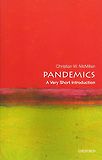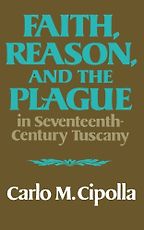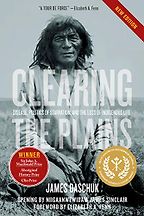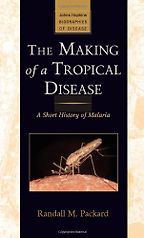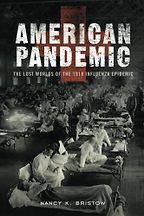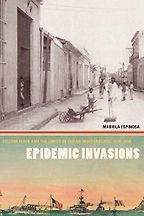With coronavirus in the news, pandemics are on the minds of many, but few who have not read your book on the subject (or the books you recommend here) could precisely define what a pandemic is. How do you define pandemic?
The most basic definition is that a pandemic is a very large epidemic which affects a large number of people across a swath of time and space. Generally, pandemics cross national boundaries, and often modern pandemics cross oceanic boundaries. That’s the way I’ve defined it in my book.
Please give us a precis of your book Pandemics: A Very Short Introduction.
The book looks at how pandemics unfold over time and how societies deal with them, with chapters focusing on HIV, cholera, malaria, smallpox and tuberculosis. I show how breakthroughs in medicine changed our relationship to these diseases.
I draw a distinction between acute pandemics, like cholera, and chronic ones, like tuberculosis. Cholera takes over people’s lives relatively quickly, whereas tuberculosis is a longstanding chronic pandemic; it’s never gone away. TB is pandemic in its scope, but it’s not an acute event that has a clear beginning and end, like a cholera epidemic. When cholera hits a place, such as Haiti after its 2010 earthquake, it travels through bodies and societies quickly and then dies out. You can define the cholera epidemics within a period of time, whereas TB and HIV are chronic, ongoing pandemics.
Can you convey the scale of a pandemic?
It depends on the disease. The Black Death affected Europe from 1348 to 51. It likely killed 60% of the European population. The 1919 flu pandemic hit every populated part of the planet; perhaps 100 million people over the course of one fall and early winter. And those numbers should be understood in relationship to the scale of the population, which was a fraction of what it is today.
Most epidemics are contained in time, but what is known as the Seventh Global Cholera Pandemic is an outbreak of a strain of cholera that’s been circling the globe since the late 1960s. And tuberculosis, an epidemic infectious disease, has been around for so long and affected so many people for so long that it’s probably killed more people than any other pandemic.
You explore the history and the persistence of TB in Discovering Tuberculosis. I was amazed to learn from your book that a disease I associate with the era of George Washington and Little Women continues to kill more than 2 million per year. Tell me about your book and TB.
There’s more TB now than at any time in world history. I tried to figure out why. The book covers the history of the disease since the late 19th century. The basic argument of the book is that although TB has been treatable since the arrival of antibiotics, through a variety of human decisions, it’s become more difficult than ever to control.
The first section looks at race and medicine, how beliefs about the natural susceptibility of Africans and indigenous Americans led many medical professionals to explain the persistence of the disease based on race. Then I examine the World War II era, when the BCG vaccine emerged and there was widespread hope that it could vanquish TB. It was tested on American Indian reservations and rolled out around the developing world. But many trials were poorly run, and the results were questionable. Evidence mounted that the vaccine was ineffective, while antibiotics proved to be extremely effective at treating the disease in East Africa.
“Seduced by the idea that antibiotics could be a silver bullet for tuberculosis, the medical community didn’t take the problem of drug resistance seriously”
The book then covers antibiotics. Seduced by the idea that antibiotics could be a silver bullet for tuberculosis, the medical community didn’t take the problem of drug resistance seriously. In Africa, antibiotics were often in short supply and administered poorly, so drug resistance grew, and TB became more difficult to treat.
In the fourth section of the book, I look at the global pandemic of TB-HIV co-infection. HIV compromises one’s immune system, allowing latent TB to become active TB. I look at the consequences of treating HIV and TB as separate problems, rather than trying to treat them as one pandemic.
Turning toward the five books about pandemics you selected, before we take them one-by-one, what criteria shaped your choices?
The books I selected were written by academics but can be easily digested and enjoyed by the general public. I tried to pick books that are lesser known than, for instance, Steven Johnson’s Ghost Map and John Berry’s The Great Influenza.
Let’s begin with a book about a period when plagues were endemic. Please tell me about Italian historian Carlo Cippolla’s work on the plague.
Faith, Reason, and the Plague is an extraordinary book about a couple of different visitations of the plague in a tiny Tuscan town during the seventeenth century, during a time when ideas about religion were changing. The response to the plague in Tuscany became a fulcrum for debate about whether the clergy should continue to command life beyond church doors. The emerging professional class of doctors and administrators explained concepts like contagion and infection that are obvious to us now, but which were really very new at the time.
Cippolla uses court records and other kinds of primary evidence to explore what happened when the plague arrived as science started to challenge the way religion traditionally shaped people’s belief. He does it in about 80 pages of marvellous micro-history.
So, he’s drawing the reader’s attention to how instrumental pandemics were in shaping worldviews, including religious doctrine. Can you expand on that point?
In response to the visitation of disease, this new class of medical professionals and administrators was urging the population to self-quarantine to avoid the spread of infection, while local priests, who largely had control of the population, were saying, ‘This is an act of God; to ward off the plague we need to come together for a mass.’
“In the 19th century, reservations became breeding grounds for infectious diseases like tuberculosis”
These forces were completely at odds with one another. One is suggesting, based on empirical evidence, that people need to separate themselves. The other one is saying that to stop the plague we must come together and praise God. Cippolla shows how these questions of faith and reason, as he puts it, created enormous conflicts.
Next, please tell me about James Daschuk’s Clearing the Plains.
This book examines how smallpox changed population dynamics from early contact between native people and Europeans in Canada in the 17th century through the end of the 19th century. Daschuk looks at how new mechanisms of hunting, as well as the trade in beaver fur and bison hide, spread disease amongst native people.
Get the weekly Five Books newsletter
These diseases radically altered social networks and tribal identities across an enormous swath of time and space. In the 19th century, reservations became breeding grounds for infectious diseases like tuberculosis. So, the book shows how early capitalist trade and then sequestration on reservations, led to horrific mortality among native populations, due to infectious diseases that came over with European traders and colonizers
Those who study the history of the American hemisphere, might be familiar with how powerfully pandemics have shaped history. But many are not. Can you please sketch the sweeping effects of pandemics on global affairs. For instance, in the way that they abetted the clearing of the Plains.
Daschuk looks at three alien mechanisms which altered present day Canada. The introduction of the horse allowed people to travel much faster and further. The introduction of European diseases like smallpox were transported faster and further by horse. And the introduction of trade in beaver skins and guns compounded the former two factors. Introducing guns, germs and horses radically altered the lives of native people. They played a synergistic role with one another. For instance, without the horse and without the motivation of trade diseases would likely have been isolated instead of becoming pandemics. All three of these things worked together to cause enormous disruptions, including migrations and reductions in native population.
“Every disease claims its own history,” Randall Packard, the author of your next choice, writes. Please tell us about The Making of a Tropical Disease.
The Making of a Tropical Disease looks at the origins of malaria in Africa as people began to settle around water sources and forests began to be cleared. He examines the ways in which migration and agriculture fostered the spread of malaria, through mosquitoes. He takes us all the way through the end of the 20th century, when the Bill and Melinda Gates Foundation undertook its sustained effort to eradicate malaria in the developing world.
Diseases like smallpox were successfully eradicated. Like tuberculosis, malaria is a disease that is impossible to get rid of without widespread environmental manipulation, including the eradication of mosquitoes. And with global warming, there’s the possibility that malaria will get even worse. This book is far and away the best introduction for anybody seeking to understand malaria’s importance in world history.
Both Packard and you must feel wonderful, at historians’ conferences, to work in a field of history that can save lives. Can you help us understand how epidemiologists and policy makers use the social history of pandemics to shape the future of public health?
That’s a good question. I don’t know that they do. The historical consciousness about pandemics is very shallow, unfortunately.
In Discovering Tuberculosis, I show there isn’t much historical consciousness in the way that we treat tuberculosis. Drug resistant tuberculosis emerged as a problem in the early 1960s in East Africa, particularly in Kenya. We had the opportunity to deal with the issue of multidrug resistant tuberculosis, but nothing was done. Amnesia about the problem seemed to set in until drug resistance again emerged as a topic of concern in the 1990s, as if it was a new discovery.
“Amnesia about the problem seemed to set in until drug resistance again emerged as a topic of concern in the 1990s”
In the case of HIV-TB co-infection, it was very clear in the early 1980s that wherever HIV went, TB cases shot up. In the early 1980s, researchers were very interested in thinking about how to treat the two diseases together. But, for a variety of reasons, that research was never fully pursued. Then, in the mid-aughts, co-infection came to the fore, as though it was an epic discovery, even though co-infection was a problem that had been around since the beginning of HIV.
Fascinating answer. How about American Pandemic: The Lost Worlds of the 1918 Influenza Epidemic by historian Nancy Bristow.
This is a fascinating book about a pandemic that, about a hundred years ago, was estimated to have caused perhaps as many 100 million deaths worldwide, with almost 700,000 deaths in the U.S. The scale of death was staggering.
Five Books interviews are expensive to produce. If you're enjoying this interview, please support us by donating a small amount.
The most interesting part of Bristow’s book is that she so clearly shows the ways in which both the medical profession and municipal officials had no idea what they were dealing with. Something like this hadn’t happened before on that scale. Few really understood how viruses worked at the time. Many thought the flu was a bacterial infection, when in fact it was a virus. She shows that the country was caught unaware. People panicked. The pandemic called into question the efficacy of modern medicine. And movingly, Bristow shows how so many Americans dealt with tragedy of losing multiple members of their family.
Bristow grapples with the collective amnesia that came after the influenza epidemic abated.
Bristow tries to investigate why an event that killed an enormous portion of the population in a very short period of time and affected every part of the country left so little mark on the American imagination and memory. Far fewer Americans died in World War I, yet we think of it as a keystone American event. Why doesn’t the flu pandemic hold a similar place in the national memory? It’s an interesting question.
For centuries, yellow fever was thought of as the true American epidemic. Yellow fever is topic of Mariola Espinosa’s Epidemic Invasions, which is your final selection.
It’s another great little book. One students love when I use it in class and students are always a good barometer for whether a book is palatable.
It’s about how yellow fever affected the United States in the mid-to-late nineteenth century and the origins of the outbreaks, which was traced back to Cuba. It brings up lots of interesting questions about what a powerful country can dictate to a less powerful country needs to do to control disease. The other books I selected brought up different elements of epidemics. This one is almost a diplomatic history through the lens of disease.
Espinosa examines how pandemics influence economic and political events, a topic of great relevance as novel coronavirus continues to spread from its transmission to humans in China and many are reacting to pandemic as not only a humanitarian crisis but also a political and economic event.
Epidemic invasions shows how pandemics affect trade and diplomatic relations between nations. There are similarities to the relationship between England and India in the nineteenth century vis-à-vis cholera.
Is there anything in the reaction of WHO or China to indicate that lessons are being learned from the history of pandemics?
They have best practices, which are based on prior public health history, but it seems that similar mistakes are still being made. Sorry to sound so cynical, but the lessons of the past don’t seem to be foremost in the minds of those who are handling this pandemic.
Interview by Eve Gerber
March 17, 2020. Updated: March 4, 2024
Five Books aims to keep its book recommendations and interviews up to date. If you are the interviewee and would like to update your choice of books (or even just what you say about them) please email us at [email protected]

